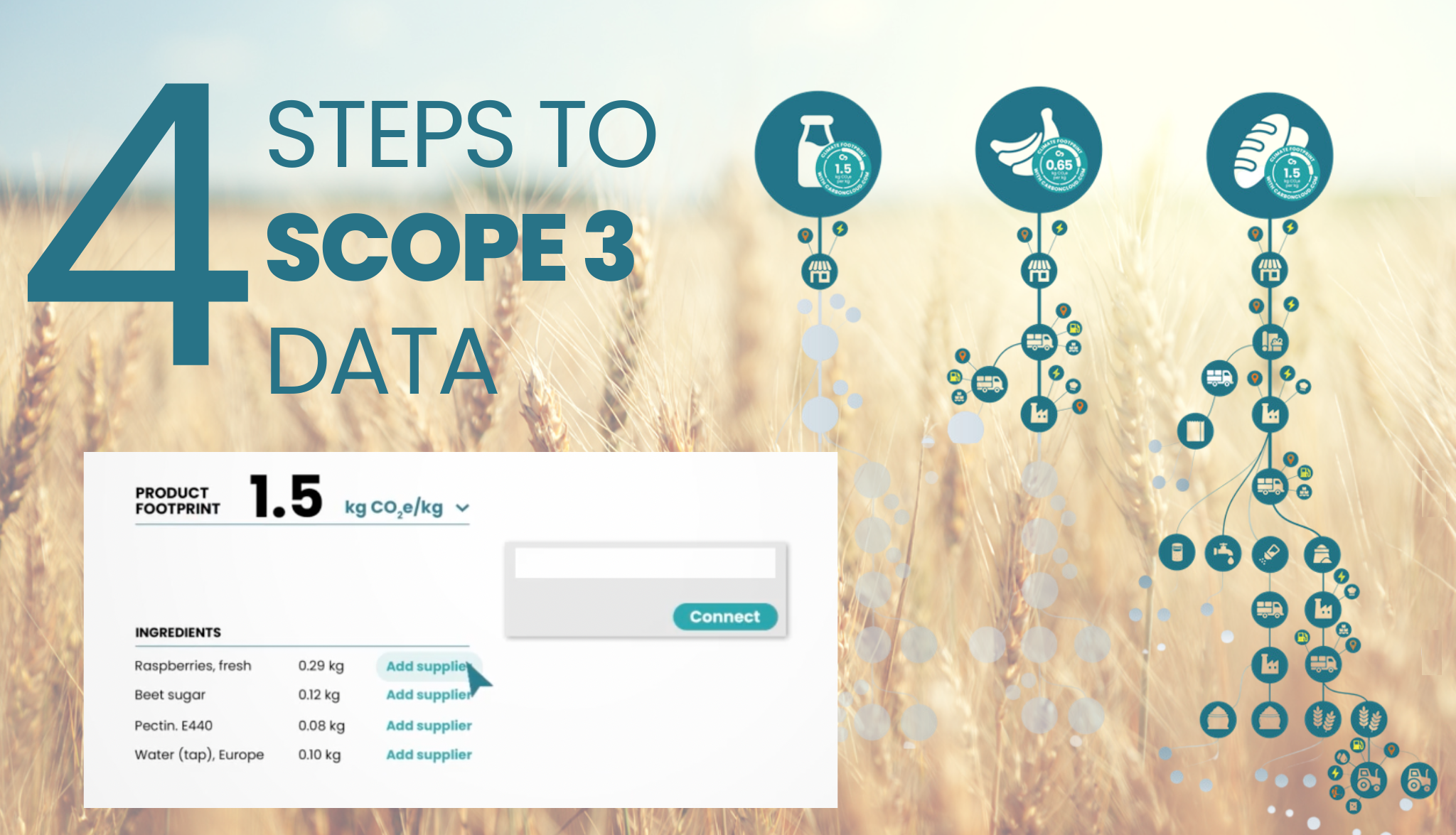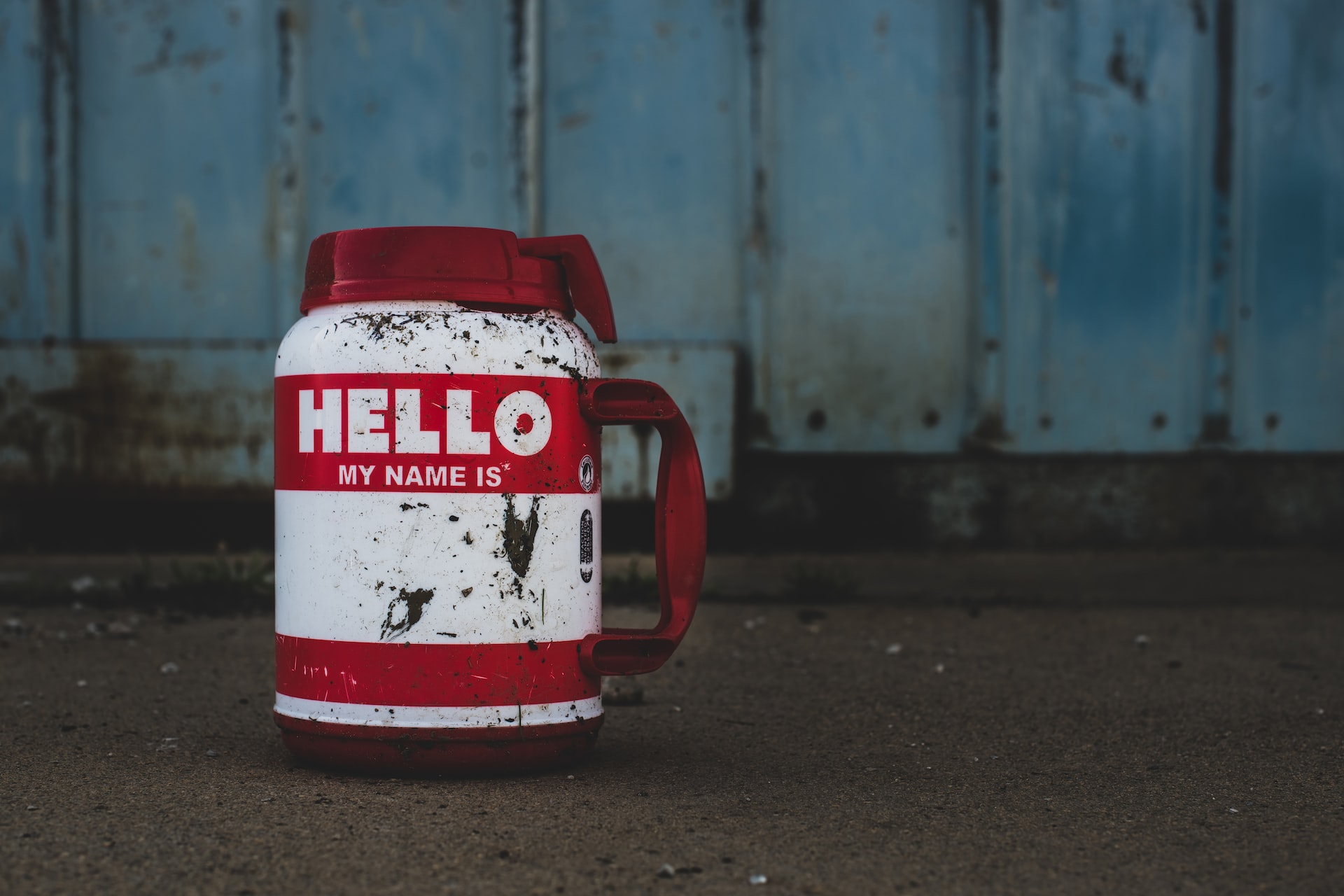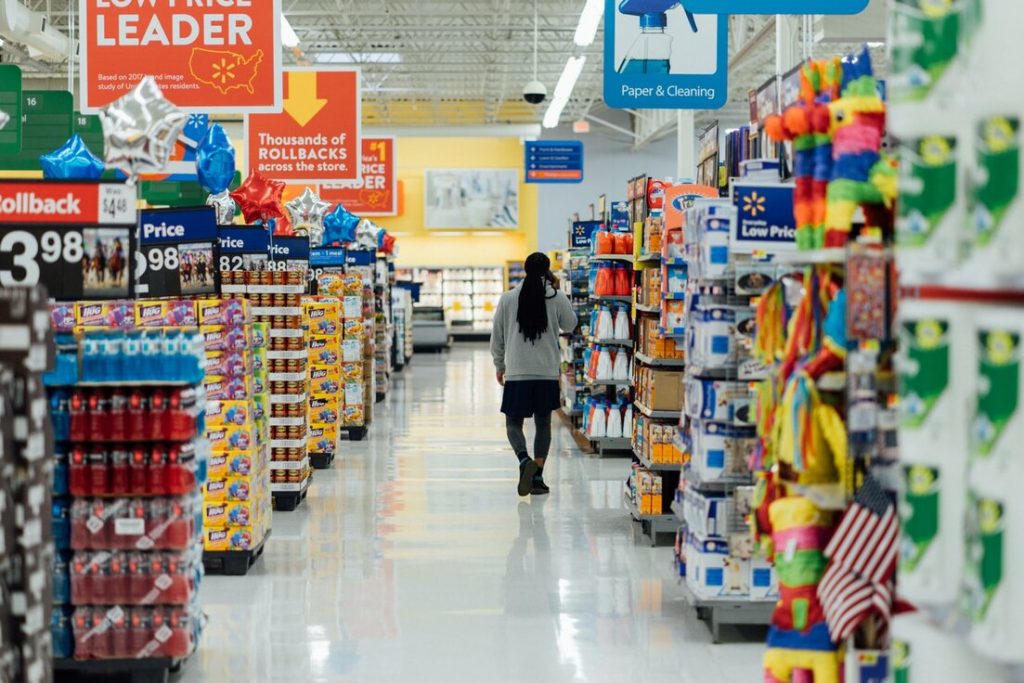4 steps to Scope 3 data: Roadblocks & how to overcome them
Food & beverage industry + Emissions + Elephant in the room = Supply chain data. Upstream Scope 3 data is a problem the entire food industry has identified but no one has successfully solved – yet. The roadblocks toward primary data are completely legitimate but certainly solvable. Here is how to overcome them with 4 steps and some conviction!
Why is the food industry rowdy about Scope 3 data?
The why of primary data is a touchy subject, as companies are charged by different motives. Primary data from the supply chain is the holy grail for what it does as well as what it signals.
SUSTAINABILITY LEADERSHIP
To start with, primary emissions data from a food company’s supply chain signals maturity and leadership. When the world’s largest players are admitting to the challenge of obtaining it and are halfway there, food companies with primary data on their radar are signaling a leading position in the race for emissions reductions.
EMISSIONS REDUCTIONS
Secondly and more practically, primary emissions data is key to unlocking reduction incentives and opportunities beyond the industry average. A food company with primary data from the supply chain of its products can quickly:
- Prioritize reduction initiatives
- Act effectively on procurement strategies
- Reduce climate change mitigation costs.
The faster and more effectively a company can move on to reductions, the quicker its product can claim the competitive advantage of “lowest emissions” against its competitors.
RISK MITIGATION
Finally, neglecting Scope 3 data is a triple-natured risk: Reputational, financial, operational. Failing to address climate risks in and from the food supply chain, particularly agriculture, impacts the financial performance of the company and leaves its operations vulnerable to the effects of climate change. Sitting out Scope 3 emissions management and reporting is a market signal that the company leaves these risks unaddressed and is more vulnerable to financial losses.
Food industry executives are well aware of this. You’ll be pressed to find a food manufacturer’s sustainability report without a plan or intentions for supply chain emissions data and reductions. However, supply chain data collection claims have been going on for a while in the industry and Scope 3 emissions not only remain largely unmapped but they keep increasing. What’s stopping the plans from materializing?
What are the roadblocks in Scope 3 data collection?
Identifying the problem of scope 3 data collection is as far from a listicle as it gets – but an accurate problem identification is the largest leap toward the solution. Case in point, a fresh study in Nature from A. Stenzel and I. Waichman researched exactly that: Supply-chain data sharing for scope 3 emissions (2023).
Stenzel and Weichman identified three main obstacles in obtaining emissions data from suppliers with corresponding proposed solutions.
1. REGULATIONS
The regulatory obstacles stated in the study are not the ones a seasoned sustainability expert would have top of mind, i.e. lack of regulated standardization. Stenzel and Weichman explain that data ownership and competition regulations, which are critical in other contexts, become roadblocks to sharing emissions data. Such regulations immobilize players in the supply chain who are willing to be transparent with their data but lawfully disabled.
Regulators, who already moving in the right direction with mandatory climate disclosures, can optimize bills and legislations to facilitate a transparent view of corporate emissions. Stenzel and Weichman recommend mandating Scope 3 disclosures with prescriptions on supply chain data quality and incentives for first movers. In addition, the study recommends removing regulatory barriers to data sharing or restructuring existing laws to account for emissions data sharing.
2) DATA HARMONIZATION & INTEROPERABILITY
Stenzel and Weichman confirm what sustainability experts have long known and advocated to solve: A lack of harmonization in measuring. As the study explains, there is room for interpretation in existing standards resulting in unharmonized, incomparable metrics. Nevertheless, Stenzel and Weichman add that even if measurement standardization is solved, the obstacle will persist:
(…) even if all firms along a supply chain agree to a certain calculation standard, they still face a lack of action interoperability. Current data exchange is realized with high manual efforts and surveys or spreadsheets leading to high costs (…)”
Stenzel & Weichman, 2023
The lack of digital infrastructure in supply chain emissions information exchange is a subsequent obstacle for the industry in mapping out its emissions fully and holistically. As the study points out, the current pathway of surveys, spreadsheets and manual information exchange is not only a costly alternative and waste of resources, but it is not proving to be a sufficient industry solution either.
A digital infrastructure with networked capabilities and a consistent measurement framework is a catalyst in overcoming the obstacles of harmonization and information exchange. Stenzel and Weichman also recommend to private-public partnerships or private coalitions to consolidate existing frameworks in a consistent measuring approach that removes room for interpretation. Nevertheless, these initiatives are moving too slowly to provide a solution in time and so far have exacerbated the “wait and see” response.
3) DATA PRIVACY
Industry executives themselves have clear-cut data privacy requirements from the Scope 3 digital infrastructure. The study presents interesting results from a relevant survey:
- 57% of German executives are anxious about core data and trade secrets being exposed and identify this concern as an obstacle to sharing data.
- 59% of the respondents also stated that lacking visibility of who can access their data is a “very big” or “rather big” obstacle in sharing their data.
The result is evident in the market. Suppliers are concerned about the privacy of their data, exacerbating the data collection challenge in consumer-facing companies.
One clarification is critical: The information vendors are after is really emission metrics, i.e. the climate footprint of products. Sensitive data such as recipes, production capacity, routes and other trade secrets indeed improve the accuracy of carbon footprints. However, as long as suppliers are performing the measurements on a private end, with the same measuring approach and in the same digital infrastructure, they do not need to disclose any of this sensitive data. The study adds that that the digital infrastructure needs to enable data owners to set limitations on their data usage and protect the data input and analysis of the measurement while enabling accountability.
Scope 3 data collection in 4 steps
Stenzel and Weichman’s study approaches Scope 3 data from a systemic perspective as any study should do. However, translating these systemic solutions into actions is a matter of business. Here’s how food & beverage companies and grocers can start collecting emissions data from their supply chain and complete their emissions map with primary data in 4 steps. These 4 steps are linear, so make sure that you have completed each step before you move on the next one.
Step 1: Get the right digital infrastructure
The singular solution that will enable a company in the food industry to defeat the system hurdles is the right digital infrastructure. Build your Scope 3 data approach on a digital system that ticks every item in this list:
- Has a unified measurement approach
- Enables automated supplier engagement
- Automates emissions information exchange
- Is prepared to replace generic data with primary data from the supply chain
Searching for such a system in the blind will seem like a huge quest. It may help you to start your search with CarbonCloud, which was developed to solve exactly -literally exactly– these needs and problems. The fact that the food industry is identifying supply chain emissions data as a pressing problem too, makes us hopeful that we will reach a solution faster.
👉 Wondering what ESG software is right for your company? Check out our ESG Software Guide with the right tech stack for every need!
In short, what your company is after is climate intelligence. Much like business intelligence, a climate intelligence platform for the food supply chain will give you the data infrastructure and analytics for data-driven decisions along your supply chain.
Step 2: Inform suppliers with clarity
Important! This step does not refer to the operational part of collecting supplier data! Your digital infrastructure should and must take this load. If suppliers are to get on board with providing data, the process should be as easy for them -and you- as possible.
Step 2 is all about preparing your suppliers to ensure their engagement with automatic data collection. At this stage, make sure that you set clear expectations for your suppliers. Inform them about:
- Your company’s determination to collect primary emissions data from the supply chain
- The wins for both from your collaborative work
- Rewards and repercussions
- The timeline of your plan
- How and where they can provide their data
- The metrics they need to provide
- How their data privacy is ensured
Keep in mind that your suppliers will need to roll out the same process to their suppliers, so communicating your conviction and the benefits of this work for them is critical. As the Stenzel and Weichman study showed, reassuring them about the ownership of their data and the security of their trade secrets is also key to alleviating their doubts. Once your suppliers are prepared, you are ready to roll out your data collection automation.
Step 3: Prioritize risks and suppliers
The destination is of course the same: Primary data for every step and commodity of the supply chain. However, what you prioritize will determine how you get there. There are two approaches to prioritizing primary data from the supply chain. Both are valid and helpful. The choice is between which process is a better fit for your supply chain:
A) Prioritize the process: Direct suppliers
This approach is valid in ensuring the completion of primary data collection across your supply chain, as in itself it is a long and challenging task. With the direct supplier approach, you start rolling out your data collection automation to the suppliers you are in direct contact with. With this request, you are also passing along the torch to your suppliers to follow the same process with their suppliers and continue the loop until the beginning of the supply chain, the farm.
- The pro of this approach is more control over the process, since you have direct communication channels and short feedback loops. As a result, you can manage the traction of your data collection process, and if needed speed it up.
- What you are trading off with this approach is that your emissions hotspots may appear later, as the process is linear. In addition, you are relinquishing some control further down the process, as you rely on the accountability of your suppliers to propagate the work. To counteract this potential downside, leverage your direct communication channels to cement Step 2 and ensure that the operational shift is crystal clear and here to stay.
B) Prioritize the insights: High-risk commodities
This approach is suitable for companies who are eager to start with targeted reduction initiatives as quickly as possible and already have a lower resolution mapping of their supply chain emissions. With the high-risk commodity approach, your data collection automation starts with the commodities of the highest climate impact, prioritizing insights throughout these paths of the supply chain. In other words, instead of increasing your data resolution throughout your portfolio, you are choose to zoom in to high-impact commodities with higher definition.
- What you win with this approach is speed: Companies following their high-risk commodities to the deep end will be able to kickstart impactful reduction initiatives along these paths in parallel to the data collection work.
- The trade-off of focusing on high-risk commodities is that it requires a preliminary low-resolution image of your supply chain emissions, to ensure that you are indeed focusing on the right parts of your portfolio. In addition, your organization and suppliers needs to be mature enough to manage two parallel climate priorities. Finally, your reliance on your direct supplier mobilization to propagate the work to their suppliers is slightly higher.
Step 4: Propagate the work – Incentives and penalties
Step 2, communicating your operative change with clarity will get you as far as your direct channels. Propelling Step 3 further down your supply chain depends on your direct suppliers. To cast forth data collection to the supply chain effectively, actions are your direct channel. Once you have enough primary data from your direct suppliers, you have sufficient data definition to start transforming your supply chain and procurement operations.
At this stage, incentivize suppliers who improve their performance or propagate the data collection work further down the supply chain. Enable them to adopt your infrastructure, reward suppliers who continue the work to their suppliers, financially support reduction initiatives, encourage adoption of new technologies, and base your product optimization and new product development on their commodities.
Suppliers unresponsive to incentives and resistant to data collection or emissions reduction measures will require counteractive measures. Discontinuing suppliers that hinder your company from reaching its business goals is the strongest index that your business is taking climate goals seriously. Moreover, suppliers resisting this business transformation are riskier business partners as their business survival is already in question.
Throughout this process, keep your eyes on the prize: Emissions reductions. It is the reason why primary data from the supply chain is business-critical and where it adds the largest value. The facts that a) emissions data is a competitive advantage for your suppliers as well, and b) you all save time and money with the right digital infrastructure, make leading the low-emissions market for food a double-win situation for your entire supply chain.
Related Posts
The net-zero transformation is data-driven
Tackling climate change is complex and change leaders often remark that there is no silver bullet. At CarbonCloud we not only agree with this point; we actively engage with it. But something comes dar
Climate Action in the Food Industry: Half-Baked Efforts as 44% of Companies Remain at Initial Maturity Level
An in-depth analysis of 83 global companies in the food system reveals mixed levels of maturity along 6 dimensions of climate performance, but with a projected positive trajectory of climate action in
Explorer–Navigator–Trailblazer: Product packages with a story
You are casually browsing through the CarbonCloud website, you find some interesting stuff and you decide the check the Product packages page. Or, you are already talking to one of our lovely Salespeo
Retailer climate targets: What’s coming for suppliers?
You spoke; we listened. When we asked food product and brand owners what their biggest pains are, their response was loud and clear: Retailers. Getting listed, pitching, branding, competitive edge,







